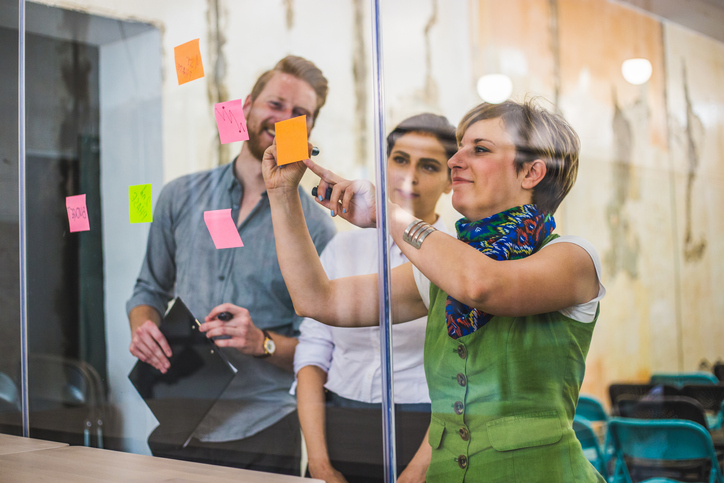
You can tell a lot about Vanessa Shaw just by looking at her LinkedIn profile. She’s the founder of Human Side of Tech and works with HR & Talent. She’s passionate about design thinking and engaging employees around the world. Most of all, she believes in bringing empathy and humanity into the world of tech.

The first thing you’ll learn when you speak with Vanessa is that she advocates for putting employees at the center of solving challenges with the goal of building better workplace cultures. Her passion for bringing humanity into HR is unparalleled, and we were lucky enough to sit down with her to talk about how companies can use design thinking to engage their remote workers.
Could you tell me about Human Side of Tech and your role as CEO?
I focus on supporting HR people and talent leaders to learn design thinking methods. The origin of my company is in response to a lot of people in the space of HR and talent acquisition wanting to transform what HR means for organizations and what those roles and functions in a company actually do.
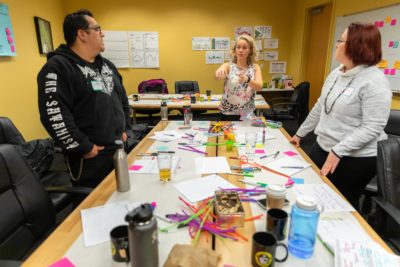
With this movement emerging towards looking at how we create driving company cultures, a lot of our ideas are lofty. But how do you break these lofty ideas down into real action items and create a great process for solving problems and building a great employee and candidate experience?
I’ve spent a lot of time working overseas with multinationals that have global offices in 25 countries. They needed to figure out a way to get aligned across a large group of stakeholders, with the added complexity of having different backgrounds, unique cultures, and different time zones. That was my entry point into the work.
And then with culture, it’s all about what actions can you take — how you take new strategies and approaches to this kind of work.
What do people operations and talent leaders need to know about design thinking?
You might be wondering why you keep hearing about design thinking in HR. It’s a big buzzword but still a big mystery to many of us. The shortest way to define it is this: design thinking is a more creative way to solve problems by including the people you’re designing for in the process.
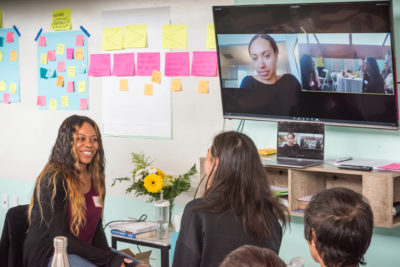
There are two key things that make design thinking really unique. The first thing is that you start with empathy. That empathy guides you toward understanding the challenge your users face. In the HR space, it translates to asking, “What’s really going on for the employees?” Usually this question can be answered by administering a survey, having empathy interviews, hosting focus groups, and getting closer to the humans you’re trying to design for.
The second aspect of design thinking is building prototypes quickly. Design thinking tells engineers and product managers to go build a bunch of prototypes and test them — this gives them the opportunity to fail until they come up with something that works.
It’s a method that fuels teams to do great work and also changes the perception of the role of HR & talent acquisition.
How does co-creation and community-driven learning help HR teams scale?
How do you take that philosophy of prototyping and build it into the HR space? How can you apply it to creating a new candidate experience or onboarding or a new talent management philosophy? That’s what we work on.
“My goal is to empower the teams I work with as quickly as possible to be better at collaborative problem solving so they don’t need me there.”

I’ve had the opportunity to work with hundreds of HR and talent teams through this community-based method. My business is a little unique in the sense that I’m not seeking out billable hours. My goal is to empower the teams I work with as quickly as possible to be better at collaborative problem solving so they don’t need me there.
My model is based on educating through co-creation and community. We have an online global community called The Workplace Lab — a place for people ops and talent acquisition professionals to put design thinking into practice and solve pressing workplace problems. We experiments and give each other feedback — it’s a community coaching group with a focus on learning design thinking and human-centered leadership skills together.
What does it look like to bring an empathy-based approach to people ops?
Design thinking is similar to the scientific method, where you create a hypothesis, perform an experiment, see if it confirms your hypothesis, then retest by implementing what you learned until you get a compelling outcome. You can take that thinking and apply it to customers — how they’re going to buy, how they’re going to behave, what their challenges are, and what their needs are.
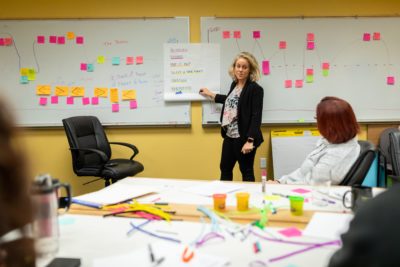
Now, it’s a little different to bring it into the workplace environment where you’re going to use it on employees and with candidates. The practice of applying empathy exercises to learn about your fellow colleagues changes the experience of the workplace culture in the process. This is why design thinking is so powerful for HR and talent leaders, it helps you improve culture as you are solving problems — not just afterwards when you are implementing the solutions.
You immediately change your culture because the way you’re engaging with people has changed. You now see them as people you need to intentionally design a better employee experience with their help. And then you shift your thinking to designing with them, in partnership. You’re building a prototype and you need feedback from real people. That creates a sense of co-creation and when you go to implement there is already a certain level of employee buy-in on the initiatives that they’ve had a hand in designing with you.
“Empathy practices from design thinking immediately change your culture because the way you’re engaging with people has changed.”
How do you start a new program using design thinking?
I’ll give you an example: I know an HR leader whose company was starting a new program. They had all sorts of initiatives, and the senior leader said, “Okay, great to have you on the team — here are your priorities. Go tackle them.”
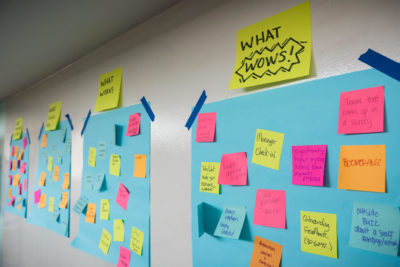
And she said, “No, actually, I’m not going to do any of that. I’m going to go on a listening tour for the next month. For the next four weeks, my job is to listen to people. I’m going to have coffee and listen to their lived experience and empathize with their challenges.”
This is another principle of design thinking: going in with empathy and seeing what we discover. Essentially, she discovered that there was upset in the Engineering team around titles, and the path to career advancement was really muddled.
She set some time aside and showed Engineers her prototype. They picked it apart and told her what they liked and didn’t like, and she built another prototype. They repeated this process a few times and together, they co-created a revised version.
She brought her HR talent expertise and they brought their lived experiences as the end-users who are going to be affected by this. Through that, she built trust and buy-in through her user group, and she built a better product because the Engineers were part of the process. They had insights she didn’t have.
“Instead of HR building a product based on what we think people need, [design thinking] opens up the doors, invites people in, gives them a role, and asks them to participate.”
She also built trust with execs through this process. Instead of HR building a product based on what we think people need, this method opens up the doors, invites people in, gives them a role, and asks them to participate. They not only feel heard, seen, and validated, but they also feel engaged and motivated to co-create their workplace culture.
How do you apply this same philosophy to your remote workforces?
If someone is working remotely, how do we know what works best to support them? How do we run performance reviews with them? How do we provide feedback? How do we make them feel included when we throw an office party and they’re not there?
The answer doesn’t lie within HR or googling, “How do we support our remote employees?” The answer is in talking to your people and getting connected to them.
How do you include remote workers in the conversation?
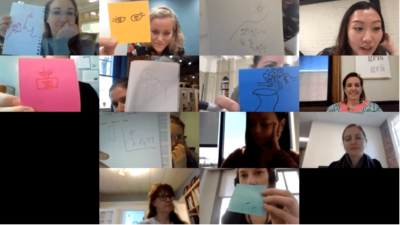
Conduct empathy interviews and listen to the feedback, especially with remote workers and outsourced teams. One of the methods in design thinking is you set out different persona groups, and you can identify your remote employees as people who have unique design needs that you need to accommodate for. For example, when solving this challenge with clarifying Engineering roles, one of the key pieces of feedback was that the prototype was built with only in-person Engineers in mind. The prototype had to be reworked because remote engineers needed to be better included in the conversation, and their needs weren’t initially met.
The remote Engineering team helped refine the new initiative to be inclusive to the variety of needs. When you include other voices, they’re going to feel engaged and like they’re not forgotten.
What are three ways to keep your remote workforce engaged?
First, ask yourself an important question: do we have technology that supports people that aren’t here? Human Side of Tech focuses on technology tools to help make that happen, which absolutely plays a role. We want to be able to have access to all the same documents through cloud computing.
“First, ask yourself an important question: do we have technology that supports people that aren’t here?”
1. Make Inclusion a Habit
The other thing that gets less attention is asking: how are we creating habits and rituals to make sure remote employees are regularly represented in conversations? One way to do that is on a virtual call where everyone is calling in from different places. You might have a mix where some people are in offices and some are calling in from home — in that kind of situation, you want to have a virtual “buddy,” meaning an in-office colleague that has the specific role of advocating for the people dialing in. They’re the helping hand to advocate for remote employees and make sure they can get in on the conversation in a really specific role.
2. Use Tools that Focus on Staying Connected
Before Donut — an app that helps facilitate communication between virtual offices — existed, people were manually setting up remote coffee dates and meetings to get people onboarded. Human Side of Tech encourages businesses to use these virtual tools to stay connected. Rewards and recognition platforms like Fond work that way too, where employees around the world can stay connected to each other and send recognition.
3. Run a “Remote Week” Experiment
Another thing that’s helpful is to put everyone in the shoes of someone being remote. A team could do a “remote week” where everyone works from home. They all have the experience of being that remote person who can’t come in the office, and you empathize with the experience better. At the end of the week, you debrief what you learned and ways you can co-create to make the experience for the people working remote better. This way, your remote people feel engaged and included in the team.
 One company did a “remote month” when they were seriously exploring having an entirely remote team. They sent employees home with care packages on how to set up their desk while working from home, supplies, and guides on how to communicate to your family that you’re working from home. They did tons of pre-work before the actual departure because they really wanted to build it as a prototype for a potential officeless company. Now, they’re doing more research on whether it’s a long-term solution. They’re really setting themselves up for success by prototyping the idea instead of making a rash choice and eliminating offices because rents are going up.
One company did a “remote month” when they were seriously exploring having an entirely remote team. They sent employees home with care packages on how to set up their desk while working from home, supplies, and guides on how to communicate to your family that you’re working from home. They did tons of pre-work before the actual departure because they really wanted to build it as a prototype for a potential officeless company. Now, they’re doing more research on whether it’s a long-term solution. They’re really setting themselves up for success by prototyping the idea instead of making a rash choice and eliminating offices because rents are going up.
What are some creative ways you can engage with companies in other countries?
My first thought is to ensure they get the recognition they deserve. Go out of your way to get them a gift certificate to a local restaurant in their area. Try to provide an experience rather than a thing. Even better: if you can make your rewards and recognition easy and just send your coworker points through a platform, the person in that other country can redeem those points for something in their country that they have access to and they want.
“If you can make your rewards and recognition easy and just send your coworker points through a platform, the person in that other country can redeem those points for something in their country that they have access to and they want.“
It’s also important to look culturally at what perks and gifts are good to give, so a creative way to engage global workforces or remote people is to use a Slack channel to discuss ways you celebrate holidays in your region, traditional gifts to give to people, and unique customs. You can use that information to understand each other.
I think it’s important to recognize that the local context needs to inform us of what’s appropriate. Have the local office communicate back to the head office of what’s appropriate. Keep your recognition localized, even in your gift giving.
Vanessa has seen her share of leaders around the world and understands the flaw of workplace practices. You can learn more about her live workshops, company offsites and the global community of HR & Talent leaders who are looking for something different, by bringing human-centered practices to their work inside The Workplace Lab.
